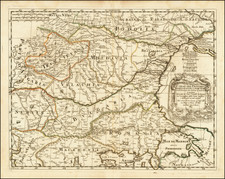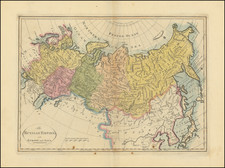A rare separately-issued map depicting the Ukraine-Crimea Theater of the Russo-Turkish War of 1735-1739, based on original sources from the Russian Imperial Academy of Sciences.
This attractive and fascinating work was the definitive map of the main theater of the Russo-Turkish War of 1735 to 1739, to be printed in England. It embraces all of the Ukraine and extends from the mouths of the Danube, along the Black Sea to include Crimea, and over as far east at the Don Valley, and north to a point on the Dnieper Valley, just north of Kiev. The war, between Czarina Anna's Russia and the Ottoman Empire, was one of a long series of conflicts whereby Russia sought to expel the Turkish presence from the Ukraine and Crimea.
The map details all of the different regions and political jurisdictions in full color, and copiously labels all towns and forts. It was issued by John Senex while the war was still in progress, and is based on Joseph-Nicolas De L'Isle's map, Theatrum Belli Ao MDCCXXXVII. a milite Augustae Russorum Imperatricis adversus Turcas Tattarosque, which was published by the Russian Imperial Academy of Sciences in St. Petersburg in 1737. De L'Isle's map, in turn, was itself based on manuscript sketch maps by Field Marshal Burkhard Christoph von Münnich, the German engineer, who was the commander of the Russian army in the region.
Relations between the Russian and Ottoman empires had always been tense, and often broke out into war. In the previous three centuries, the Turks had conquered much territory in the Balkans, Romania and the Ukraine, including, part of the latter, which became the Khanate of Crimea. The Russians not only wanted to stave off further Turkish advances, but also wanted to 'liberate' fellow Christians from Muslim rule.
By the mid-1730s, Russia had succeeded in securing a favorable international situation by signing treaties with Persia in 1732-5 (a traditional enemy of the Ottomans) and in 1735, supporting the accession of Augustus III to the Polish over the French candidate Stanislaw I Leszczynski (France was a Turkish ally). Since 1726, Russia had maintained a valuable alliance with Austria.
In 1735, war was provoked by the raids of the Crimean Tatars on Russian territory. Russia was also alarmed by the khanate's military campaigns in the Caucasus. In 1736, Russia decided to mount a military campaign to drive the Turks from Crimea and the Asoz region once and for all.
On May 20, 1736, the large Russian Army of the Dnieper, with 62,000 troops, under the command of Field Marshall von Münnich, took the Turkish fortifications at Perekop and occupied Bakhchisaray on June 17. However, poor supply lines and the outbreak of an epidemic forced Münnich to retreat to Ukraine.
On June 19, the Russian Army of the Don under the command of General Peter Lacy, with 28,000 troops, and the support from the Don Flotilla under the command of Vice Admiral Peter Bredahl, seized the fortress of Azov. In July 1737, the Münnich's Army seized the Turkish fortress of Ochakov. Lacy's army then marched into the Crimea the same month, inflicting a number of defeats on the forces of the Crimean Khan and capturing Karasubazar. However, Lacy and his troops had to leave the Crimea due to a lack of supplies.
The Crimean campaign of 1736 proved to be a fiasco, as it ended in a complete Russian withdrawal after its armies sustained 30,000 casualties.
In July 1737, Austria entered the war against the Ottoman Empire, but was defeated in a number of battles in the Balkans. The year 1738 saw a hiatus in the conflict, while Russia, Austria and the Ottoman Empire, began protracted negotiations.
In the summer of 1739, the Russian army regrouped, commanded by Münnich, and crossed the Dnieper, defeating the Turks at Stavuchany and occupying the fortress of Khotin and Ia?i. However, Austria was defeated by the Turks at Grocka and signed a separate treaty in Belgrade with the Ottoman Empire on August 21. These factors, combined with the imminent threat of the Swedish invasion, forced Russia to sign the Treaty of Niš with Turkey on September 29, 1739, which ended the war on the terms of status quo ante bellum.
The present map is rare, and was separately-issued. We are aware of only a single example of the map appearing in a dealer catalog in the last 25 years and no examples at auction.
John Senex (1678-1740) was one of the foremost mapmakers in England in the early eighteenth century. He was also a surveyor, globemaker, and geographer. As a young man, he was apprenticed to Robert Clavell, a bookseller. He worked with several mapmakers over the course of his career, including Jeremiah Seller and Charles Price. In 1728, Senex was elected as a Fellow of the Royal Society, a rarity for mapmakers. The Fellowship reflects his career-long association as engraver to the Society and publisher of maps by Edmund Halley, among other luminaries. He is best known for his English Atlas (1714), which remained in print until the 1760s. After his death in 1740 his widow, Mary, carried on the business until 1755. Thereafter, his stock was acquired by William Herbert and Robert Sayer (maps) and James Ferguson (globes).











![Gibraltar to Berlin. [World War II Broadside Map.]](https://storage.googleapis.com/raremaps/img/small/83480.jpg)
![[War pf Austrian Succession]. Theatrum Belli Sive Novissima Tabula Qua Maxima Pars Danubii Et Praeserium Hungaria Cum Aliis Adiacentibus Regnis Nec Non Graecia, Morea, et Archipelagi Insulae…](https://storage.googleapis.com/raremaps/img/small/89541.jpg)
![[ Earliest Obtainable Map of Russia, Ukraine, and the Caucauses ] Secunda Asiae Tabula](https://storage.googleapis.com/raremaps/img/small/82673.jpg)
![[ Finland - Theater of War ] Theatre de la Guerre en Finlande Pour l'Intelligence des Mouvements des Troupes Suedoises et Moscovites . .. 1742](https://storage.googleapis.com/raremaps/img/small/95511.jpg)